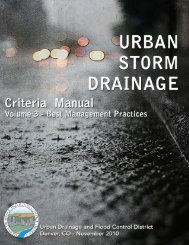Hydraulic Efficiency of Grate and Curb Inlets - Urban Drainage and ...
Hydraulic Efficiency of Grate and Curb Inlets - Urban Drainage and ...
Hydraulic Efficiency of Grate and Curb Inlets - Urban Drainage and ...
Create successful ePaper yourself
Turn your PDF publications into a flip-book with our unique Google optimized e-Paper software.
1<br />
0.9<br />
Observed<br />
0.8<br />
0.7<br />
0.6<br />
0.5<br />
0.4<br />
0.3<br />
0.2<br />
0.1<br />
0<br />
1 ft depth<br />
0.5 ft depth<br />
0.33 ft depth<br />
Equal<br />
0 0.1 0.2 0.3 0.4 0.5 0.6 0.7 0.8 0.9 1<br />
Predicted<br />
R 2 Average efficiency error (%) Maximum efficiency error (%)<br />
0.948 3.8 15.7<br />
Figure 5-7: Predicted vs. observed efficiency for Type R curb inlet from improved UDFCD methods<br />
<strong>Efficiency</strong> predictions by the UDFCD methods were improved slightly for each <strong>of</strong> the<br />
inlets tested. The methods were extended to include the Type 13 <strong>and</strong> 16 combination inlets, with<br />
efficiency over-predicted by an average <strong>of</strong> 10%. For these inlets, agreement with observed test<br />
data is still best at low flow depth. For the Type R curb inlet, UDFCD methods were modified<br />
slightly, <strong>and</strong> efficiency error spread evenly at 3.8%. Agreement is still best at higher flow<br />
depths, <strong>and</strong> has been improved for the lowest depth. <strong>Efficiency</strong> predictions can be further<br />
improved by developing new empirical relationships for each inlet.<br />
5.3 <strong>Efficiency</strong> from Dimensional Analysis <strong>and</strong> Empirical Equations<br />
In this section empirical equations are presented, as an alternative to the use <strong>of</strong> the<br />
UDFCD methods, for determination <strong>of</strong> inlet efficiency for the Type 13 combination, Type 16<br />
combination, <strong>and</strong> Type R curb inlets. Equations presented will provide a simpler <strong>and</strong> more<br />
accurate method, than that presented in the USDCM, for determining efficiency in the on-grade<br />
condition. Methods presented in the USDCM suffer from, in part, use <strong>of</strong> theoretical parameters<br />
that can not be physically determined by a user (such as splash-over velocity, R f , R s , Q w , <strong>and</strong> Q s ).<br />
61
















